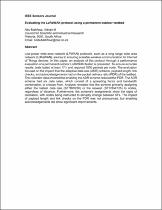JavaScript is disabled for your browser. Some features of this site may not work without it.
- ResearchSpace
- →
- Research Publications/Outputs
- →
- Journal Articles
- →
- View Item
| dc.contributor.author |
Marais, JM

|
|
| dc.contributor.author |
Malekian, R

|
|
| dc.contributor.author |
Abu-Mahfouz, Adnan MI

|
|
| dc.date.accessioned | 2019-09-25T07:32:51Z | |
| dc.date.available | 2019-09-25T07:32:51Z | |
| dc.date.issued | 2019-06 | |
| dc.identifier.citation | Marais, J.M., Malekian, R. & Abu-Mahfouz, A.M.I. Evaluating the LoRaWAN protocol using a permanent outdoor testbed. IEEE Sensors Journal, vol 19, no. 2, pp. 4726-4733 | en_US |
| dc.identifier.issn | 1530-437X | |
| dc.identifier.issn | 1558-1748 | |
| dc.identifier.uri | https://ieeexplore.ieee.org/document/8648485 | |
| dc.identifier.uri | DOI: 10.1109/JSEN.2019.2900735 | |
| dc.identifier.uri | http://hdl.handle.net/10204/11130 | |
| dc.description | Copyright: 2019. IEEE. This is an abstract. The definitive version of the work is published in the IEEE Sensors Journal, Vol. 19, no. 12, pp. 4726-4733 | en_US |
| dc.description.abstract | Low-power wide-area network (LPWAN) protocols, such as a long range wide area network (LoRaWAN), are key to ensuring scalable wireless communication for Internet of Things devices. In this paper, an analysis of this protocol through a performance evaluation of a permanent outdoor LoRaWAN tested is presented. To ensure accurate results, tests lasted at least 17 h and required 1000 packets per node. The evaluation focused on the impact that the adaptive data rate (ADR) scheme, payload length, link checks, and acknowledgements had on the packet delivery ratio (PDR) of the testbed. The collected data showed that enabling the ADR scheme reduced the PDR. The ADR scheme had six data rates, which consist of a spreading factor and bandwidth combination, to choose from. Analysis revealed that the scheme primarily assigning either the fastest data rate (SF7BW250) or the slowest (SF12BW125) to nodes, regardless of distance. Furthermore, the scheme's assignments show the signs of oscillation, with nodes being instructed to abruptly change between SFs. The impact of payload length and link checks on the PDR was not pronounced, but enabling acknowledgements did show significant improvements. | en_US |
| dc.language.iso | en | en_US |
| dc.relation.ispartofseries | Workflow;22609 | |
| dc.subject | Internet of Things | en_US |
| dc.subject | IoT | en_US |
| dc.subject | Low-power wide-area network | en_US |
| dc.subject | LPWAN | en_US |
| dc.subject | Long range | en_US |
| dc.subject | LoRa | en_US |
| dc.subject | LoRa wide area network | en_US |
| dc.subject | LoRaWAN | en_US |
| dc.title | Evaluating the LoRaWAN protocol using a permanent outdoor testbed | en_US |
| dc.type | Article | en_US |
| dc.identifier.apacitation | Marais, J., Malekian, R., & Abu-Mahfouz, A. M. (2019). Evaluating the LoRaWAN protocol using a permanent outdoor testbed. http://hdl.handle.net/10204/11130 | en_ZA |
| dc.identifier.chicagocitation | Marais, JM, R Malekian, and Adnan MI Abu-Mahfouz "Evaluating the LoRaWAN protocol using a permanent outdoor testbed." (2019) http://hdl.handle.net/10204/11130 | en_ZA |
| dc.identifier.vancouvercitation | Marais J, Malekian R, Abu-Mahfouz AM. Evaluating the LoRaWAN protocol using a permanent outdoor testbed. 2019; http://hdl.handle.net/10204/11130. | en_ZA |
| dc.identifier.ris | TY - Article AU - Marais, JM AU - Malekian, R AU - Abu-Mahfouz, Adnan MI AB - Low-power wide-area network (LPWAN) protocols, such as a long range wide area network (LoRaWAN), are key to ensuring scalable wireless communication for Internet of Things devices. In this paper, an analysis of this protocol through a performance evaluation of a permanent outdoor LoRaWAN tested is presented. To ensure accurate results, tests lasted at least 17 h and required 1000 packets per node. The evaluation focused on the impact that the adaptive data rate (ADR) scheme, payload length, link checks, and acknowledgements had on the packet delivery ratio (PDR) of the testbed. The collected data showed that enabling the ADR scheme reduced the PDR. The ADR scheme had six data rates, which consist of a spreading factor and bandwidth combination, to choose from. Analysis revealed that the scheme primarily assigning either the fastest data rate (SF7BW250) or the slowest (SF12BW125) to nodes, regardless of distance. Furthermore, the scheme's assignments show the signs of oscillation, with nodes being instructed to abruptly change between SFs. The impact of payload length and link checks on the PDR was not pronounced, but enabling acknowledgements did show significant improvements. DA - 2019-06 DB - ResearchSpace DP - CSIR KW - Internet of Things KW - IoT KW - Low-power wide-area network KW - LPWAN KW - Long range KW - LoRa KW - LoRa wide area network KW - LoRaWAN LK - https://researchspace.csir.co.za PY - 2019 SM - 1530-437X SM - 1558-1748 T1 - Evaluating the LoRaWAN protocol using a permanent outdoor testbed TI - Evaluating the LoRaWAN protocol using a permanent outdoor testbed UR - http://hdl.handle.net/10204/11130 ER - | en_ZA |






